SNOW DAY ON BERGEN & FLATBUSH (1888)
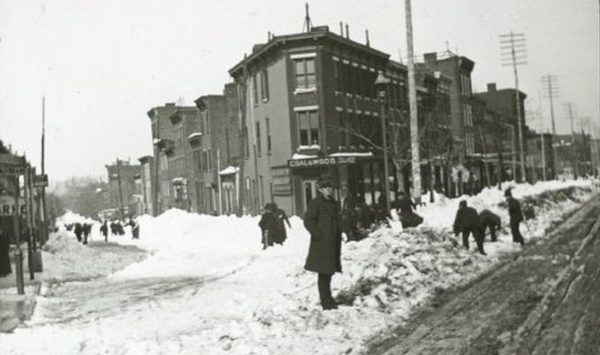
******************************************************************************************************************************** Brownstone Detectives investigates the history of our clients’ homes. The story you are about to read was composed from research conducted in the course of one of those investigations. ******************************************************************************************************************************** Although today was merely a dusting in comparison to the Blizzard of 1888, it gives us an opportunity to look back on what the aftermath of a real snowstorm looked like. In the inset black & white photograph, we see men clearing snow outside of a coal & wood store after the blizzard at the corner of Flatbush Avenue and Bergen Street. We’ve included a Google Maps view of what that corner looks like today. The Coal & Wood shop is now a Gino’s Pizza at 218 Flatbush Avenue. Follow @BrownstoneDetec Share ———————————————————————————————————————– The Brownstone Detectives Brownstone Detectives is a property research agency. Our mission is to research, document, and save the histories of our clients’ historic properties. From this research, we produce our celebrated House History Books. Each book is fully cited, featuring detailed narratives and colorful graphics, and is designed to bring the history of any house to life. Contact us today to begin discovering the history of your home.
BROOKLYN: 66 VIEWS OF THE STORM (1888)
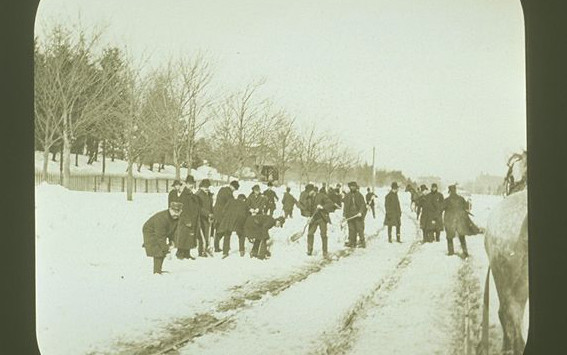
******************************************************************************************************************************** Brownstone Detectives investigates the history of our clients’ homes. The story you are about to read was composed from research conducted in the course of one of those investigations. ******************************************************************************************************************************** In 1888, Adrian Vanderveer Martense, a member of an old Brooklyn Dutch family and resident of Flatbush, snapped 66 photographs throughout the 1888 Blizzard. Those photographs are with us to this day at the Brooklyn Visual Heritage. According to the Brooklyn Historical Society, the Martense family built a homestead in Flatbush which included land that is now part of Green-Wood Cemetery. Their homestead stood for several generations until the family sold it in 1889, when Flatbush was transitioning from a farming community into an inner suburb. For Adrian Vanderveer Martense, Flatbush became a subject for his photography. He documented houses, streets, and his friends and neighbors in Flatbush, as well as the momentous Blizzard of 1888. Follow @BrownstoneDetec Share ———————————————————————————————————————– The Brownstone Detectives Brownstone Detectives is a property research agency. Our mission is to research, document, and save the histories of our clients’ historic properties. From this research, we produce our celebrated House History Books. Each book is fully cited, featuring detailed narratives and colorful graphics, and is designed to bring the history of any house to life. Contact us today to begin discovering the history of your home.
Poor Oscar Moore, Fell & Hit The Floor (1884)
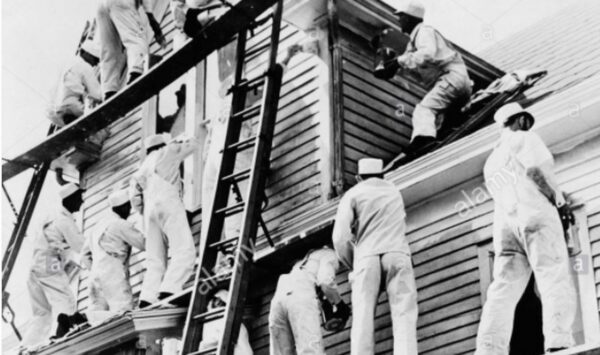
******************************************************************************************************************************** Brownstone Detectives investigates the history of our clients’ homes. The story you are about to read was composed from research conducted in the course of one of those investigations. Do you know the history of YOUR house? ******************************************************************************************************************************** We Brooklynites can sense history all around us. It does not jump out at us like ghosts or drift in our direction like disembodied voices from walls. But we know it is there. Sometimes it takes a little physical research to understand what it is that happened at a particular location, though – just to see it. Take the case of the brownstone at No. 272 South 5th Street in Williamsburg, for example – literally, at the base of the Williamsburg Bridge. The facade shows what appears to be an unassuming 3-story and basement 19th century tenement. But something once happened there – literally, right there out in front of the house – that changed a man’s life. POOR OSCAR MOORE A short piece in the Brooklyn Daily Eagle of 11 January 1884, noted that a painter, by the name of Oscar Moore, who lived at 143 Marcy Avenue, had been working on a scaffold at the Fifth Street location, painting the front of “No. 272 South Fifth Street.” Then he fell. According to the paper, Moore “sustained a severe fracture of the right side.” It is likely that a surgeon was dispatched to tend to Moore. He probably did little more than assess Moore’s status and then, with the help […]
SUNSETTING ON A BED-STUY BOULEVARD (1909)
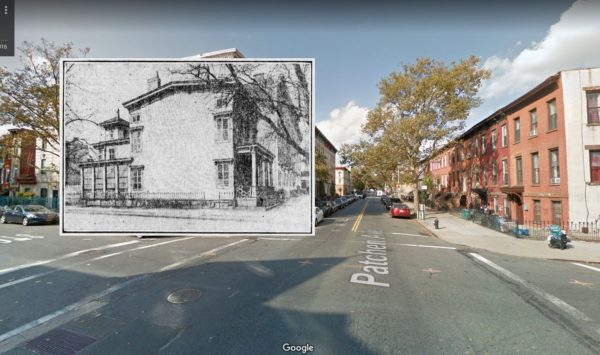
******************************************************************************************************************************** Brownstone Detectives investigates the history of our clients’ homes. The story you are about to read was composed from research conducted in the course of one of those investigations. Do you know the history of YOUR house? ******************************************************************************************************************************** In 1909, a landmark was about to be destroyed. It was quite common, though, at the time for owners to tear down the antiquated wood-frame mansions that dotted Brooklyn’s lamdscape. Since the new brownstone houses had become all the rage in the 1880s, these tinder “firetraps” had become redundant, difficult to sell, and simply unstylish to live in. By the late 19th century, they were being sold, in many cases, for the value of their land as building lots. And with the demise of these historical artifacts, went some truly beautiful examples of mid-19th century architecture, few of which remain with us to this day. THE DE MILLE HOUSE The De Mille house was built around the middle of the 19th century for the family of that name, “and it has been a landmark in that region since the days when it was surrounded by open fields.” Yes, even Bedford-Stuyvesant – today chockablock with brownstone and masonry homes – was once – even before the advent of wood-frame homes – forested land alongside open virgin fields. As a matter of fact, the corner of Quincy and Patchen, in the 1850s, was little more than hills, dales, dirt lanes, and the vague promise of a future suburban city. “Broadway, which is nearby, […]
THE LOST ART OF MOVING HOUSES (1900)
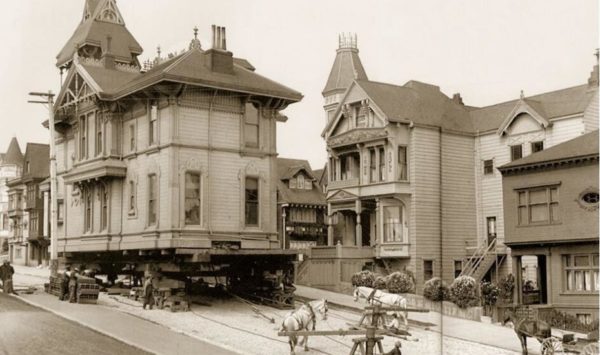
******************************************************************************************************************************** Brownstone Detectives investigates the history of our clients’ homes. The story you are about to read was composed from research conducted in the course of one of those investigations. Do you know the history of YOUR house? ******************************************************************************************************************************** An article in the 28 March 1900 edition of the Brooklyn Daily Eagle caught our eye the other day. It detailed an old practice of moving houses, and it took place in a time when the economics were such that their transport to another lot made more fiscal sense than tearing them down wholesale. In this story, however, the time it took to move this particular house took a toll on the neighboring residents. And, at one point, they gathered to tear the house down, themselves… THE HOUSE IN THE STREET The story took place in the early part of 1900 in Flatbush at the corner of Flatbush Avenue and Linden Boulevard. The subject was a frame structure that was being moved from that corner, although not quickly enough for local residents who protested the house’s temporary location on Linden Boulevard. And by “on Linden Boulevard,” we mean on the actual roadway itself. “A frame building stands in the middle of Linden boulevard, at its junction with Flatbush avenue. The building bears the sign of Vanderveer & Williamson, real estate agents,” the reporter started his story. Vanderveer & Williamson, we discovered – through combing the newspaper’s archives – were Adrian Vanderveer and Adrian N. Williamson, who had, by this point, had […]
FIRE, FUN & FIASCOES ON THE 4th (1887)
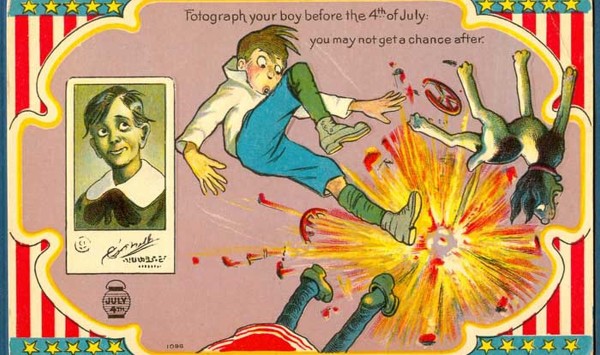
******************************************************************************************************************************** Brownstone Detectives investigates the history of our clients’ homes. The story you are about to read was composed from research conducted in the course of one of those investigations. Do you know the history of YOUR house? ******************************************************************************************************************************** A lot of accidents happen on the 4th of July. While it has been a day of celebration for Americans since its inception, certain citizens have tended to go a bit too far with their fireworks and other dangerous weapons. Back in 1887, a few days after Independence Day, a listing of the damages occurring and casualties effected on that date appeared in the Brooklyn Daily Eagle – once the authorities had had the time to assess the collective destruction. “Pistols and pyrotechnics of every kind were used with absolute impunity by even mere children,” the paper noted, “and the wonder is that more accidents did no occur.” The following list reflects a number of police blotters and lays out the accidents occurring primarily in the Eastern District (Williamsburg and Bushwick areas, and parts of Bed-Stuy). It is partial, but it will 1) boggle your mind, and 2) make you laugh. FIRE CRACKERS AS ASSAULT WEAPONS 8:30 – A boy whose identity could not be discovered threw a firecracker at the peanut stand outside the frame building at 21 Grand street and set it on fire. The building, which was owned and occupied by Sauer Brothers as a saloon, was damaged to the amount of $500 before the flames were extinguished. […]
THE PSYCHE OF 192 ST. JOHN’S PL. (1889)
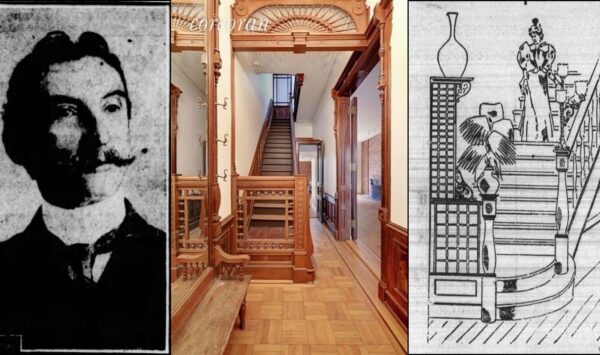
******************************************************************************************************************************** Brownstone Detectives investigates the history of our clients’ homes. The story you are about to read was composed from research conducted in the course of one of those investigations. Do you know the history of YOUR house? ******************************************************************************************************************************** Starting in the late 1880s, the Brooklyn Daily Eagle started a series of articles which described – in great length and detail – the interiors of individual newly-built or renovated houses. These houses were usually brownstones belonging to those affluent or upper-middle-class members of society. Not only did such articles describing the interiors of neighbors’ homes sell newspapers, but the articles also served as advertising directed at those in the market for a townhouse who wanted a home of their own. These advertisement-articles were placed, likely at the expense of the designers responsible for the “interior decorations” being described, as each piece often ended with what readers wanted to know: “Who did the work?” “THE WORK WAS DONE BY A. KORBER” Albert Korber, who went by “A. Korber,” was an architect and designer who settled in Brooklyn at the age of 15. Three years later he “started business on Adams street as a manufacturer of picture frames and moldings. Several years later he founded the decorating business which bears his name, with showrooms on Montague street and a factory for the manufacture of interior woodwork and furniture in South Brooklyn.” By 1889, Korber was 42, a successful decorator throughout the City of Brooklyn. Although he was held in high esteem for […]
THE BOERUM HILL SNAKE-OIL MAN (1885)
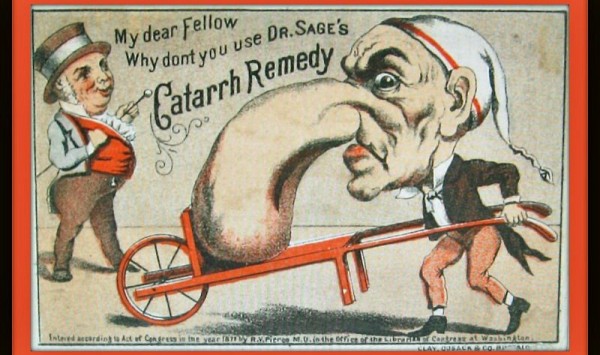
******************************************************************************************************************************** Brownstone Detectives investigates the history of our clients’ homes. The story you are about to read was composed from research conducted in the course of one of those investigations. Do you know the history of YOUR house? ******************************************************************************************************************************** If you climbed to the third floor of 375 Pacific Street in 1885, two floors above its stable, and you passed through “several mysterious little doors,” you might find “a little room where seven girls were busily engaged” in filling and labeling numerous clear bottles. And if you thought, while climbing the thin stairway and passing through the oddly small doors, that perhaps you were entering upon the quarters of a crime syndicate or those of a mafia den, you would not have been too very far from the truth. MAKING, BOTTLING, AND SELLING THE CURE Years before the Pure Food and Drug Act was signed into law in 1906, patent medicine salesmen were plying the U.S. mails with great success. Although their “cures” brought their clients considerably less success, their hopes were still strong and snake oil continued to sell at a good clip. Patent medicine salesmen were everywhere, advertising everywhere, and came from a number of professions – failed doctors, teachers, tinsmiths, and even wood engravers. What a wood engraver might have known about medicine was probably never in dispute – all he needed to know was how to sell a product – what was in dispute was the fact that his “cure” did nothing other than make the […]
SPRING BRINGS THE BEAN SHOOTERS (1863)
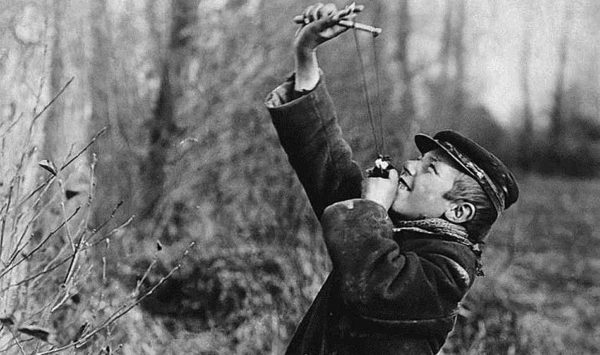
******************************************************************************************************************************** Brownstone Detectives investigates the history of our clients’ homes. The story you are about to read was composed from research conducted in the course of one of those investigations. Do you know the history of YOUR house? ******************************************************************************************************************************** There were a LOT of bad little boys in Brooklyn in the 19th century. Sifting through old issues of the Brooklyn Daily Eagle, the Standard Union, and other Brooklyn papers, I come across evidence of this on a daily basis. Of all the crimes that I see having been committed, one of the most common – and interesting – is the work of the “bean shooters.” When I was a kid I had a bean-shooter myself – and I did the same thing. There were a lot of broken window panes in my neighborhood – some I was found guilty of breaking – and most others of which I got away scot free of any blame whatsoever. (There was always the suspicion, though, that I was the culprit.) But I digress. Let’s rewind, though – further back to the mid- to late-1800s, and take a look at the work of my fierce little boy predecessors. BEAN-SHOOTING IN 19TH CENTURY BROOKLYN While sling shots (or often called “slung shots”) were a constant presence in the hands of gang members and criminals (they were outlawed by the New York State Legislature in 1849), it seems that the use of such a device by boys, with any degree of consistency, did not come until […]
THE “GOETHE” AT No. 461 GREENE AVE. (1890)
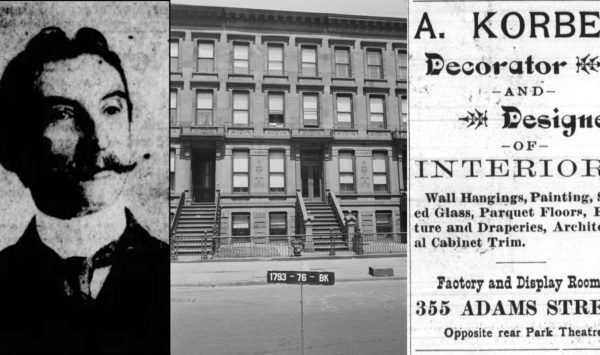
******************************************************************************************************************************** Brownstone Detectives investigates the history of our clients’ homes. The story you are about to read was composed from research conducted in the course of one of those investigations. Do you know the history of YOUR house? ******************************************************************************************************************************** Starting in the late 1880s, the Brooklyn Daily Eagle started a series of articles which described – in great length and detail – the interiors of individual newly-built or renovated houses. These houses were usually brownstones belonging to those affluent or upper-middle-class members of society. Not only did such articles describing the interiors of neighbors’ homes sell newspapers, but the articles also served as advertising directed at those in the market for a townhouse to have a home of their own. These advertisement-articles were placed, likely at the expense of the designers responsible for the “interior decorations” being described, as each piece often ended with what readers wanted to know: “Who did the work?” WORK WAS DONE BY A. KORBER Albert Korber, who went by “A. Korber,” was an architect and designer who settled in Brooklyn at the age of 15. Three years later he “started business on Adams street as a manufacturer of picture frames and moldings. Several years later he founded the decorating business which bears his name, with showrooms on Montague street and a factory for the manufacture of interior woodwork and furniture in South Brooklyn.” By 1889, Korber was 42, a successful decorator throughout the City of Brooklyn. His specialty was making the entrance to a house […]